PSYC 170 - Summer 2013 - Professor Claffey
Notes: Lateralization
PDFBackground
________________ - function is more dependent on one
hemisphere (left/right) than the other
contralateral - across/different sides
ipsilateral - same side
Contralateral systems: vision, somatosensory, motor control (not hearing)
Physiological Asymmetries
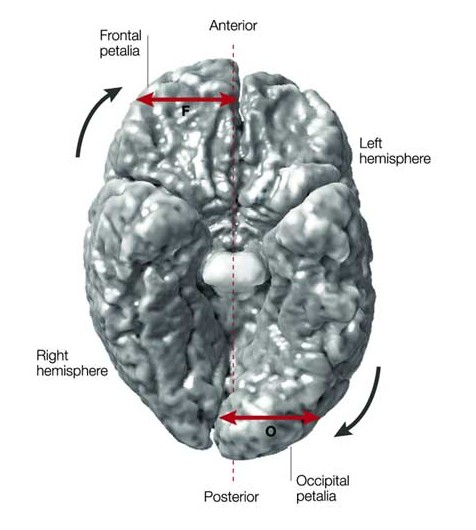
|
Note: left and right are reversed in the image Right frontal lobe tends to extend farther forward, Left occipital lobe tends to extend farther back (Galaburda et al, 1978) Evidence for this asymmetry in 60,000 year old fossils (Lemay, 1976) Differences in neurotransmitters greater dopamine and dopamine receptors in left globus pallidus (basal ganglia) (Glick, Ross & Hough, 1982) greater norepinephrine in right thalamus (Oke et al, 1978) |
theory that one hemipshere leads or dominates the other in function
originated by Hughlings Jackson in 1860s
oldest, strongest version of the theory was that right hemisphere did little more than sensory processing
modern view tends to see hemispheres as being specialized/cooperative
Language
________________
problems with speech
typically patients with aphasia have damage
to ________________ hemisphere
handedness
95% of right handed people
have language in left hemisphere (Rasmussen & Milner, 1977)
left handed people usually
have language in the left hemisphere
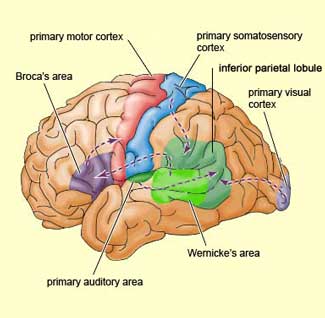 Source: mybrainnotes.com/memory-language-brain.html |
Paul Broca & Carl Wernicke - physicians in 1860's - performed autopsies on people with aphasia - noticed the reliability of damage to left hemisphere - earliest evidence for lateralization in the brain Lesions to Broca's area (Broca's aphasia) - difficulties in speech production - can still comprehend language Lesions to Wernicke's area (Wernicke's aphasia) - difficulty in comprehending language - fluid (but nonsensical) speech production Videos: Broca's aphasia - old, recent Wernicke's aphasia - old |
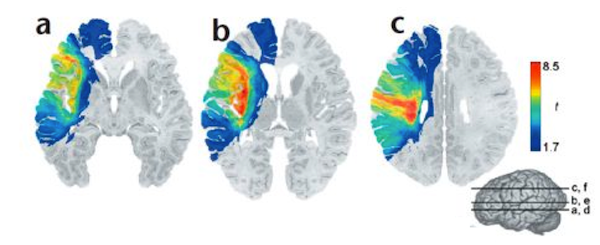
above figure shows area which, if damaged, produced the greatest
different between stroke patients and healthy individuals in fluency
101 stroke patients with left hemisphere damage
Language & the right hemisphere
Better at identifying prosody (rythym & stress) - emotive content of language
Cannot understand long/complicated grammatical structures (Zaidel, 1978)
Can understand basic dichotomies ("The girl stood up" versus "The girl did not stand up")
Vocabulary is largely limited to concrete words (Zaidel, 1990)
Unable to identify phonological properties of speech (e.g. identify rhymes) (Levy & Trevarthen, 1977)
Split-brain patients
____________________________ can be surgically cut (commissurutomy)
done either experimentally (animals) or to
treat epilepsy (humans)
effects in human patients are obvious/subtle
In cats (Myers & Sperry, 1953)
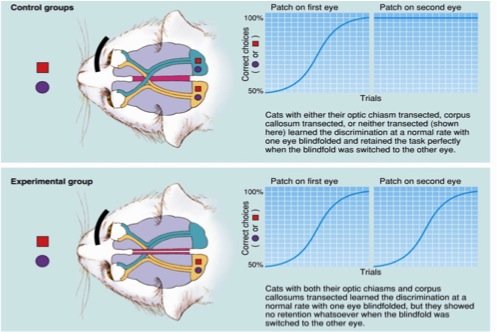 |
Details at derby.ac.uk/ostrich Four different treatments in the experiment: A. no surgery B. cut the optic chiasm C. cut the corpus callosum D. cut both optic chiasm and corpus callosum One hemisphere learned as fast as both hemispheres still connected Learning could be transferred across corpus callosum |
In humans (Gazzaniga)
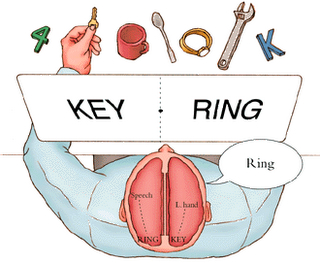 Source: brainmind.com/Brain3.html |
Details at derby.ac.uk/ostrich Patients have corpus callosum cut as epilepsy treatment Different objects/words could be presented to each hemisphere Subject could verbally report if presented to the left hemisphere, but not to the right hemisphere Subject could demonstrate object use if presented to either hemisphere (Gazzaniga et al, 1962) 2 hemispheres are functioning independently within a person Videos: Gazzaniga w/ Alan Alda, Other |
used to ___________________________ before brain surgery
anesthetize one hemisphere of the brain at a time with barbiturate (sodium amobarbital)
physician knows that the drug has its effect when temporary, contralateral paralysis is observed
can impair speech in conscious subjects
modern alternative is to use fMRI (Rutten et al, 2002)
Other
Visuospatial / Object Recognition
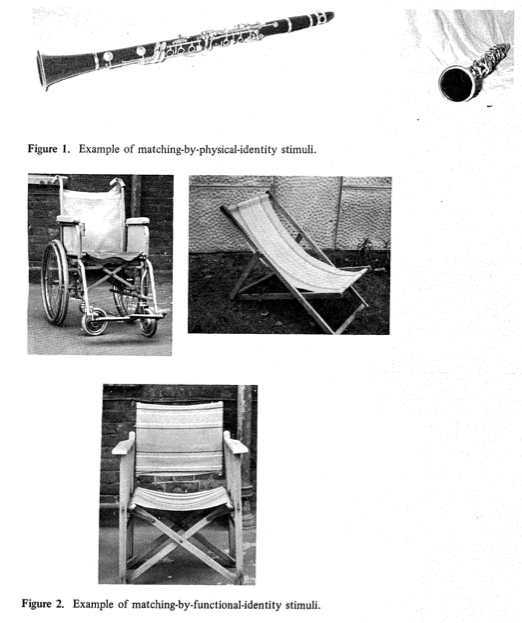 |
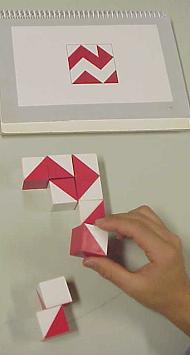 |
patients with right hemisphere lesions have difficulty recognizing
objects if they are not in their standard form (Warrington & Taylor,
1973) right hemisphere lesions are impaired at matching by perceptual similarity left hemisphere lesions are impaired at matching by semantic similarity (Warrington & Taylor, 1978) left hand can accurately perform WAIS block design task, right hand is clumsy left hand could draw 2D representations of 3D structures, right has difficulty (Gazzaniga, 1970) patients with right hemisphere lesions have difficulty judging line orientation (Benton et al, 1975) |
experiment was performed in healthy individuals, examaning two objects simultaneously
Global versus Local
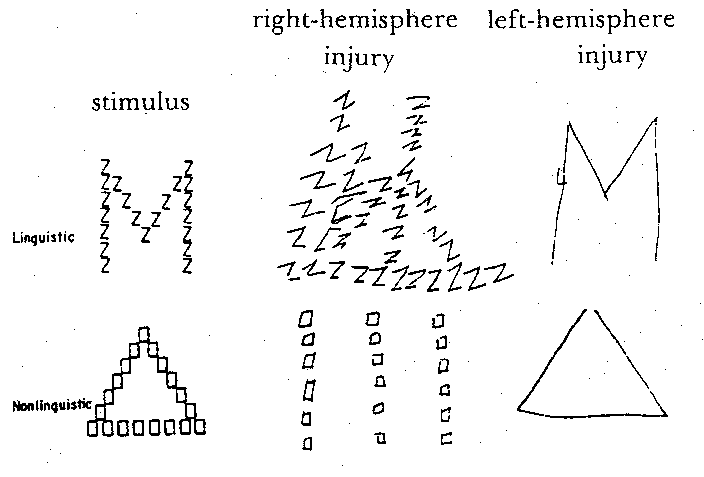 |
right hemisphere damage causes loss of big picture left hemisphere damage causes loss of local details (Review: Robertson & Lamb, 1991) Processing of metaphor, gist and inferences across text are associated with the right hemisphere (Beeman & Chiarello, 1998) |
Other
patients with right hemisphere lesions have difficultyjudging whether they have previously viewed a face (Yin, 1970)
interpreting emotional expression of faces (Bowers et al, 1985)
________________
problems initiating movement out of context
movements in context can be routines that don't rely on cortex
associated with damage to left hemisphere
____________________________
ignoring one side of the body / space / objects
typically associated with damage to right parietal lobe
Videos
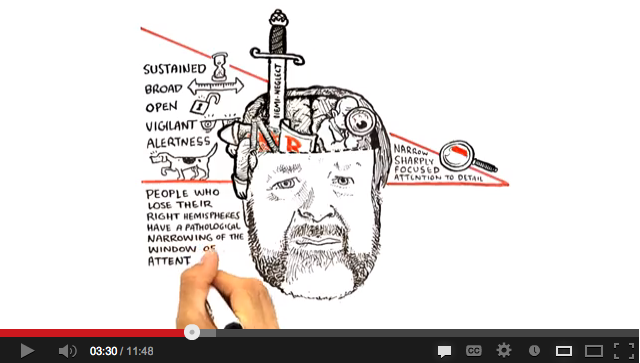 http://www.youtube.com/watch?v=dFs9WO2B8uI Theory of right for global, left for local By psychiatrist and writer Iain McGilchrist (full video of lecture) |
 http://www.youtube.com/watch?v=QTrJqmKoveU Narrative experience of stroke in the left hemisphere and what right hemisphere consciousness is like |